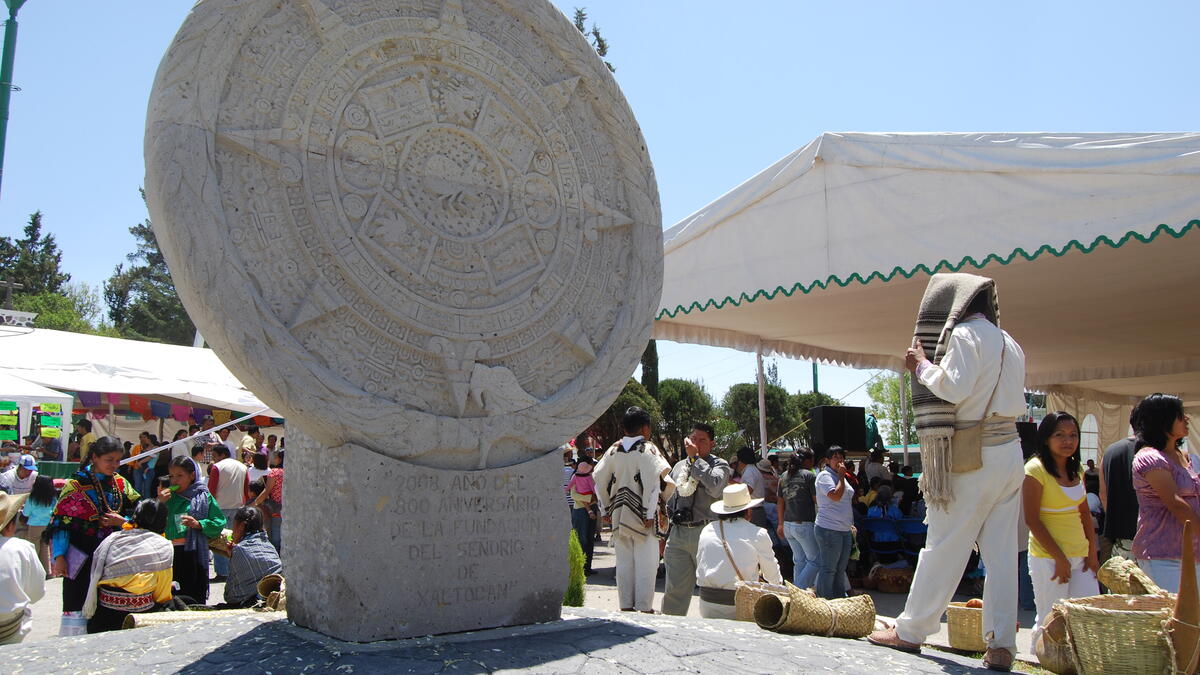Were archaeology to be defined solely by the movies, you’d assume it involves traveling to exotic lands and stealing ancient relics.
Of course it’s not, but the “Tomb Raider” trope is alive and well across the globe.
This summer, one Arizona State University archaeologist took a successful swipe at the stereotype and landed a hit.
Christopher Morehart has done quite a bit of work in the town of Xaltocan, outside Mexico City. Xaltocan predates the Aztec Empire. In 2008 the town celebrated its 800th anniversary.
“People in Xaltocan have a very strong sense of their patrimony and their identity,” said Morehart, an associate professor with the School of Human Evolution and Social Change. “They almost have a sense Xaltocan could have been Tenochtitlan, the capital of the Aztec Empire. But Tenochtitlan also became Mexico City, so saying that there’s this sense of 'We could have been the center of the Mexican nation.'”
There’s a replica Aztec calendar stone in the town. Instead of displaying the Sun God in the center, the toponym for Xaltocan occupies the spot (sand and a spider; seen at the top of this article).
Most of Morehart’s time in Xaltocan has been spent studying chinampas — Aztec raised-bed agriculture — as well as ancient terraces and canals. He studied under the first archaeologist to work successfully in the town, a woman named Elizabeth Brumfiel from Albion College.
“Prior to her, any archaeologist who tried to do work in Xaltocan got chased out,” he said. “She went there and developed a relationship with people in the town and asked them, ’Well, what do you want me to study?’ It’s very common for archaeologists to show up and say, ‘This is what I want to do.’ She created a more collaborative approach to interacting with people.”
As well as being up against the impression they’re there to swipe antiquities, archaeologists have to contend with old tales.
“For example, one of the sites we excavate now, there’s always these local myths that there’s gold someplace and the archaeologists are there to find the gold,” Morehart said. “It’s a story I heard in every town. They’re fascinating stories. They’re often stories about Spanish gold that was at a hacienda, and somebody during the revolution hid it in a cave. It’s connected to these moral statements where somebody found the gold but when they took the lid off to enrich themselves ... all these noxious gases came off and killed the person.”
Inspired by Brumfiel, Morehart cast about for a way to close the gap between town and gown.
“Frankly one of the most important ways we can combat misinformation about what we’re doing is to work very closely with the local community and to be as open as possible,” he said.
By doing public speaking events and so on, “over time, little by little, you get more of a presence,” he said. “‘Oh, you’re the archaeologist.’ People get knowledge of what you’re doing.”
After Morehart earned his PhD, he received a grant from the Wenner-Gren Foundation, a respected nonprofit benefactor of archaeology, to do some work in Xaltocan in 2013. Part of that grant was intended for outreach.
He came up the idea to do a book on the history of the town, written by all the people who had done research there, along with some of the residents. He envisioned something accessible for laymen, not an academic book.
Archaeologists had handed out copies of their work before, but they were always technical reports.
“It’s very difficult for (researchers) to have the time and energy to invest in something like this that’s not going to count a lot in terms of the annual evaluation of their CV or something like that, but will count a whole lot for a local community,” Morehart said.
Along with two colleagues from other universities who were Xaltocan veterans, Morehart began to corral anyone who had worked in the town to write about the work they’d done there “with the goal of donating it to the town.”
“It took some time because you have to get a lot of people on board, but everybody was very positive about it and we got it done,” he said.
This past summer they presented the 85-page book — “Xaltocan: Archaeology, History, and Community” — at Xaltocan’s cultural center. “It was very well received,” Morehart said. “Everybody was really excited.”
He spent an hour and a half signing copies.
“I was surprised,” he said. “I didn’t know what people would think. I thought people would be supportive, but I didn’t anticipate such an overwhelmingly positive reception of the book.”
Top photo: Aztec calendar stone in Xaltocan, Mexico. Photo courtesy of Christopher Morehart
More Local, national and global affairs

Video series tells story of 'Resettled People'
What better way for the story of former refugees to be told than having the refugees tell those stories themselves.That’s the idea behind "STEM Dreams in Motion: Stories of Resettled People."Using…

Department of State and ASU host Government Leaders Forum to strengthen semiconductor supply chains
By Emilia FrancoAs the global demand for semiconductors accelerates — with projections reaching $1 trillion by 2030 — Arizona State University, in partnership with the U.S. Department of State,…

Environmental writer, ER doctor address violence, climate change, more at sold-out ASU event
“The difficulty of understanding the consequences of heat is amplified by conventional notions of what it means to be hot. In pop culture, hot is sexy, hot is cool, hot is new…” That excerpt was…
